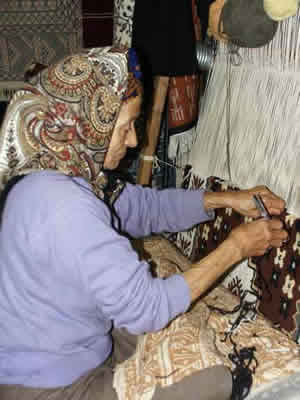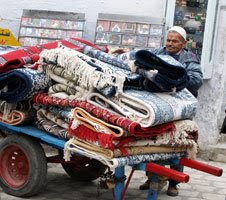Kairouan is the carpet capital of Tunisia and the main area of Ave 7 Novembre in the Medina is the place you should head to if you want to see/buy them. There are also loads on display in the Maison du Gouverneur which is a museum that doubles as a carpet shop.
"Kairouan is one of the few places in Tunisia where the women do the weaving, chatting gaily as their deft fingers ply the shuttle. They turn out two types of carpet—pile and short-nap. The latter are subdivided into mergoums, which have a diamond pattern worked into a neutral ground, and klims, formed by alternate strips of natural-colored wools. Most sought after are the zerhiyas, which are pile rugs. Their traditional design of a central motif bordered by an arabesque pattern is largely responsible for the widespread appreciation of Kairouan carpets."
source :http://www.saudiaramcoworld.com/issue/196305/craftsman.of.tunisia.htm
Tunisia has a long tradition of weaving and is famous for its rugs, mergoums, kilims, as well as other tapestries and woven products. Already in the 5th century AD, the Greek poets complimented "the rugs and cushions of Carthage" and tribute payments to the Caliph of Baghdad were made partly in the form of Tunisian rugs. See Saudi Aramco World's online article "Craftsman of Tunisia" for more information on Tunisian weaving.
source :http://www.saudiaramcoworld.com/issue/196305/craftsman.of.tunisia.htm
Tunisia has a long tradition of weaving and is famous for its rugs, mergoums, kilims, as well as other tapestries and woven products. Already in the 5th century AD, the Greek poets complimented "the rugs and cushions of Carthage" and tribute payments to the Caliph of Baghdad were made partly in the form of Tunisian rugs. See Saudi Aramco World's online article "Craftsman of Tunisia" for more information on Tunisian weaving.
In Kairouan, women do the weaving. They produce two types of wool carpet - pile and short-nap. The short- nap carpets are either of the mergoum style (a diamond pattern worked into a neutral ground), and kilims (formed by alternate strips of natural-colored wools. The pile rugs, known as zerhivas consist of a central motif bordered by an arabesque pattern. While there is some room for variation, most of these rugs follow traditional designs and motifs. The zerhivas are more expensive than the short-nap carpets and take much longer to make. Those made out of silk were considerably more expensive but were beautiful.
















0 comments:
Post a Comment